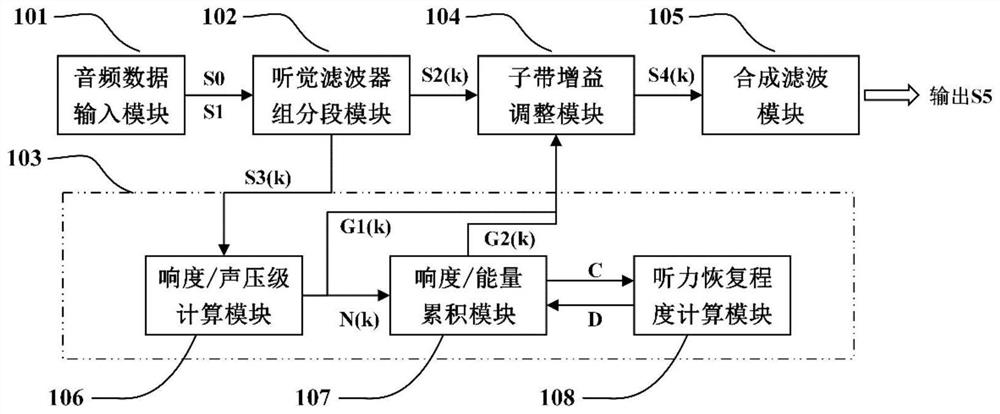Hearing protection device and method based on auditory characteristics of human ears
A hearing protection and hearing technology, applied in the directions of earpiece/headphone accessories, transducer circuits, sensors, etc., can solve the problem of ignoring the characteristics of human hearing, focusing only on volume and playback time, and cannot go further and more scientifically to protect people. hearing problems
- Summary
- Abstract
- Description
- Claims
- Application Information
AI Technical Summary
Problems solved by technology
Method used
Image
Examples
Embodiment 1
[0071] Embodiment 1: When the earphone is playing, the loudness of each sub-band of the audio is limited to prevent instantaneous damage to the human ear, such as Figure 8 Shown:
[0072] Step 201: In the case of playing audio, obtain the current input audio frame S10;
[0073] Step 202: Construct a filter Filter_11 based on the earphone frequency response curve, and filter the audio S10 using the filter Filter_11, that is, perform equalization processing according to the earphone frequency response curve to obtain the analysis signal S11;
[0074] Step 203: Based on the auditory characteristics of the human ear, construct an auditory filter bank Filter_12(k), and filter the audio frames S10 and S11 to obtain the subband signal S12(k) for gain adjustment and the subband for analysis Signal S13(k).
[0075] Specifically, the filter bandwidth is divided using the Bark scale, and its center frequency and bandwidth are shown in Table 1. Then according to the center frequency a...
Embodiment 2
[0094] Embodiment 2: When the earphone is playing, control the loudness accumulation of each sub-band signal in the audio signal, and shut down the device if necessary, so as to reduce hearing fatigue and protect human hearing. Specific steps are as follows:
[0095] Step 301: Obtain the input audio frame S20;
[0096] Step 302: collect the played sound data frame S21 in real time at the earphone playback end;
[0097] Step 303: As in step 203, construct an auditory filter bank Filter_21(k) based on the auditory characteristics of the human ear, and filter the input audio signal S20 to obtain audio sub-band signals S22(k).
[0098] The frequency band of the filter bank can be divided using the scale as in step 203, or the filter bandwidth can be divided using the ERB scale. In this embodiment, the ERB scale is used for division, and the shape of each auditory filter is determined within the range of 50-15000 Hz according to the ERB level. The ERB scale is at an interval of 0...
Embodiment 3
[0121] Embodiment 3: Loudness / energy accumulation is carried out during playback, and corresponding control is carried out to reduce hearing fatigue during long-term listening, and turn off the earphones if necessary; Can get enough rest, and finally achieve the purpose of hearing protection. Specific steps are as follows:
[0122] Step 401: collect and play sound data frame S31 (for audio analysis) in real time at the earphone playback end;
[0123] Step 402: Similar to steps 103 to 104, calculate the audio power E3(k) of each sub-band of the sound data S31;
[0124] Step 403: Calculate the cumulative energy value of each sub-band, and compare it with the preset threshold value of each sub-band to obtain the control signal C31.
[0125] The specific calculation method is as follows:
[0126] (1) According to each sub-band audio power E3(k) in step 304, calculate this frame sub-band audio energy value E c (k,i):
[0127] En(k,i)=E3(k)×LEN / Fs (8)
[0128] Where i represen...
PUM
 Login to View More
Login to View More Abstract
Description
Claims
Application Information
 Login to View More
Login to View More - R&D
- Intellectual Property
- Life Sciences
- Materials
- Tech Scout
- Unparalleled Data Quality
- Higher Quality Content
- 60% Fewer Hallucinations
Browse by: Latest US Patents, China's latest patents, Technical Efficacy Thesaurus, Application Domain, Technology Topic, Popular Technical Reports.
© 2025 PatSnap. All rights reserved.Legal|Privacy policy|Modern Slavery Act Transparency Statement|Sitemap|About US| Contact US: help@patsnap.com



